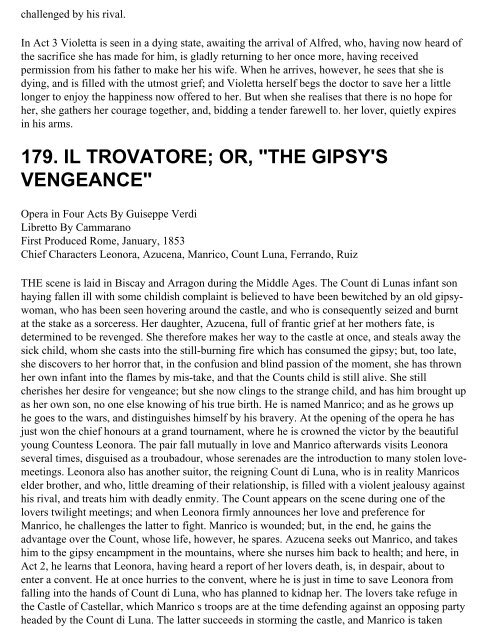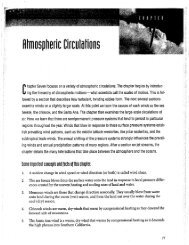Opera Plots I - MDC Faculty Home Pages
Opera Plots I - MDC Faculty Home Pages
Opera Plots I - MDC Faculty Home Pages
You also want an ePaper? Increase the reach of your titles
YUMPU automatically turns print PDFs into web optimized ePapers that Google loves.
challenged by his rival.<br />
In Act 3 Violetta is seen in a dying state, awaiting the arrival of Alfred, who, having now heard of<br />
the sacrifice she has made for him, is gladly returning to her once more, having received<br />
permission from his father to make her his wife. When he arrives, however, he sees that she is<br />
dying, and is filled with the utmost grief; and Violetta herself begs the doctor to save her a little<br />
longer to enjoy the happiness now offered to her. But when she realises that there is no hope for<br />
her, she gathers her courage together, and, bidding a tender farewell to. her lover, quietly expires<br />
in his arms.<br />
179. IL TROVATORE; OR, "THE GIPSY'S<br />
VENGEANCE"<br />
<strong>Opera</strong> in Four Acts By Guiseppe Verdi<br />
Libretto By Cammarano<br />
First Produced Rome, January, 1853<br />
Chief Characters Leonora, Azucena, Manrico, Count Luna, Ferrando, Ruiz<br />
THE scene is laid in Biscay and Arragon during the Middle Ages. The Count di Lunas infant son<br />
haying fallen ill with some childish complaint is believed to have been bewitched by an old gipsywoman,<br />
who has been seen hovering around the castle, and who is consequently seized and burnt<br />
at the stake as a sorceress. Her daughter, Azucena, full of frantic grief at her mothers fate, is<br />
determined to be revenged. She therefore makes her way to the castle at once, and steals away the<br />
sick child, whom she casts into the still-burning fire which has consumed the gipsy; but, too late,<br />
she discovers to her horror that, in the confusion and blind passion of the moment, she has thrown<br />
her own infant into the flames by mis-take, and that the Counts child is still alive. She still<br />
cherishes her desire for vengeance; but she now clings to the strange child, and has him brought up<br />
as her own son, no one else knowing of his true birth. He is named Manrico; and as he grows up<br />
he goes to the wars, and distinguishes himself by his bravery. At the opening of the opera he has<br />
just won the chief honours at a grand tournament, where he is crowned the victor by the beautiful<br />
young Countess Leonora. The pair fall mutually in love and Manrico afterwards visits Leonora<br />
several times, disguised as a troubadour, whose serenades are the introduction to many stolen lovemeetings.<br />
Leonora also has another suitor, the reigning Count di Luna, who is in reality Manricos<br />
elder brother, and who, little dreaming of their relationship, is filled with a violent jealousy against<br />
his rival, and treats him with deadly enmity. The Count appears on the scene during one of the<br />
lovers twilight meetings; and when Leonora firmly announces her love and preference for<br />
Manrico, he challenges the latter to fight. Manrico is wounded; but, in the end, he gains the<br />
advantage over the Count, whose life, however, he spares. Azucena seeks out Manrico, and takes<br />
him to the gipsy encampment in the mountains, where she nurses him back to health; and here, in<br />
Act 2, he learns that Leonora, having heard a report of her lovers death, is, in despair, about to<br />
enter a convent. He at once hurries to the convent, where he is just in time to save Leonora from<br />
falling into the hands of Count di Luna, who has planned to kidnap her. The lovers take refuge in<br />
the Castle of Castellar, which Manrico s troops are at the time defending against an opposing party<br />
headed by the Count di Luna. The latter succeeds in storming the castle, and Manrico is taken













